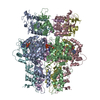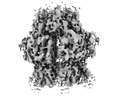+ Open data
Open data
- Basic information
Basic information
| Entry |  | |||||||||
|---|---|---|---|---|---|---|---|---|---|---|
| Title | Structure of Rep protein in SaPI1 | |||||||||
 Map data Map data | ||||||||||
 Sample Sample |
| |||||||||
| Biological species |   Staphylococcus aureus (bacteria) Staphylococcus aureus (bacteria) | |||||||||
| Method |  single particle reconstruction / single particle reconstruction /  cryo EM / Resolution: 3.9 Å cryo EM / Resolution: 3.9 Å | |||||||||
 Authors Authors | Qiao CC / Mir-Sanchis I | |||||||||
| Funding support |  Sweden, 1 items Sweden, 1 items
| |||||||||
 Citation Citation |  Journal: Nucleic Acids Res / Year: 2022 Journal: Nucleic Acids Res / Year: 2022Title: Staphylococcal self-loading helicases couple the staircase mechanism with inter domain high flexibility. Authors: Cuncun Qiao / Gianluca Debiasi-Anders / Ignacio Mir-Sanchis /  Abstract: Replication is a crucial cellular process. Replicative helicases unwind DNA providing the template strand to the polymerase and promoting replication fork progression. Helicases are multi-domain ...Replication is a crucial cellular process. Replicative helicases unwind DNA providing the template strand to the polymerase and promoting replication fork progression. Helicases are multi-domain proteins which use an ATPase domain to couple ATP hydrolysis with translocation, however the role that the other domains might have during translocation remains elusive. Here, we studied the unexplored self-loading helicases called Reps, present in Staphylococcus aureus pathogenicity islands (SaPIs). Our cryoEM structures of the PriRep5 from SaPI5 (3.3 Å), the Rep1 from SaPI1 (3.9 Å) and Rep1-DNA complex (3.1Å) showed that in both Reps, the C-terminal domain (CTD) undergoes two distinct movements respect the ATPase domain. We experimentally demonstrate both in vitro and in vivo that SaPI-encoded Reps need key amino acids involved in the staircase mechanism of translocation. Additionally, we demonstrate that the CTD's presence is necessary for the maintenance of full ATPase and helicase activities. We speculate that this high interdomain flexibility couples Rep's activities as initiators and as helicases. | |||||||||
| History |
|
- Structure visualization
Structure visualization
| Supplemental images |
|---|
- Downloads & links
Downloads & links
-EMDB archive
| Map data |  emd_12987.map.gz emd_12987.map.gz | 58.8 MB |  EMDB map data format EMDB map data format | |
|---|---|---|---|---|
| Header (meta data) |  emd-12987-v30.xml emd-12987-v30.xml emd-12987.xml emd-12987.xml | 14.5 KB 14.5 KB | Display Display |  EMDB header EMDB header |
| Images |  emd_12987.png emd_12987.png | 86 KB | ||
| Archive directory |  http://ftp.pdbj.org/pub/emdb/structures/EMD-12987 http://ftp.pdbj.org/pub/emdb/structures/EMD-12987 ftp://ftp.pdbj.org/pub/emdb/structures/EMD-12987 ftp://ftp.pdbj.org/pub/emdb/structures/EMD-12987 | HTTPS FTP |
-Related structure data
| Related structure data |  7olaC  7om0C  7pdsC C: citing same article ( |
|---|---|
| EM raw data |  EMPIAR-10945 (Title: Staphylococcal self-loading helicases couple the staircase mechanism 1 with inter domain high flexibility EMPIAR-10945 (Title: Staphylococcal self-loading helicases couple the staircase mechanism 1 with inter domain high flexibilityData size: 1.6 TB / Data #1: Rep1apo [micrographs - multiframe]) |
- Links
Links
| EMDB pages |  EMDB (EBI/PDBe) / EMDB (EBI/PDBe) /  EMDataResource EMDataResource |
|---|
- Map
Map
| File |  Download / File: emd_12987.map.gz / Format: CCP4 / Size: 64 MB / Type: IMAGE STORED AS FLOATING POINT NUMBER (4 BYTES) Download / File: emd_12987.map.gz / Format: CCP4 / Size: 64 MB / Type: IMAGE STORED AS FLOATING POINT NUMBER (4 BYTES) | ||||||||||||||||||||
|---|---|---|---|---|---|---|---|---|---|---|---|---|---|---|---|---|---|---|---|---|---|
| Voxel size | X=Y=Z: 0.82 Å | ||||||||||||||||||||
| Density |
| ||||||||||||||||||||
| Symmetry | Space group: 1 | ||||||||||||||||||||
| Details | EMDB XML:
|
-Supplemental data
- Sample components
Sample components
-Entire : Rep1 in SaPI1
| Entire | Name: Rep1 in SaPI1 |
|---|---|
| Components |
|
-Supramolecule #1: Rep1 in SaPI1
| Supramolecule | Name: Rep1 in SaPI1 / type: organelle_or_cellular_component / ID: 1 / Parent: 0 / Macromolecule list: all |
|---|---|
| Source (natural) | Organism:   Staphylococcus aureus (bacteria) / Strain: U93688 Staphylococcus aureus (bacteria) / Strain: U93688 |
| Molecular weight | Experimental: 330 KDa |
| Recombinant expression | Organism:   Escherichia coli BL21(DE3) (bacteria) / Recombinant strain: Rosetta / Recombinant plasmid: pET28 Escherichia coli BL21(DE3) (bacteria) / Recombinant strain: Rosetta / Recombinant plasmid: pET28 |
-Macromolecule #1: Rep1
| Macromolecule | Name: Rep1 / type: protein_or_peptide / ID: 1 / Enantiomer: LEVO |
|---|---|
| Source (natural) | Organism:   Staphylococcus aureus (bacteria) / Strain: U93688 Staphylococcus aureus (bacteria) / Strain: U93688 |
| Recombinant expression | Organism:   Escherichia coli BL21(DE3) (bacteria) Escherichia coli BL21(DE3) (bacteria) |
| Sequence | String: GSHMFEMIDS RTGVLNANDW KSQLRRSATT QALKKTTTNA EIILCNDESL KGLVQYDAFE KVTKLKRLPY WRSKGDANYY WADIDTTHVI SHIDKLYNVQ FSRDLIDTVI EKEAYQNRFH PIKSMIESKS WDGIKRIETL FIDYLGAEDN HYNREVTKKW MMGAVARIYQ ...String: GSHMFEMIDS RTGVLNANDW KSQLRRSATT QALKKTTTNA EIILCNDESL KGLVQYDAFE KVTKLKRLPY WRSKGDANYY WADIDTTHVI SHIDKLYNVQ FSRDLIDTVI EKEAYQNRFH PIKSMIESKS WDGIKRIETL FIDYLGAEDN HYNREVTKKW MMGAVARIYQ PGIKYDSMII LYGGQGVGKS TAVSKLGGHW YNQSIKTFKG DEVYKKLQGS WICEIEELSA FQKSTIEDIK GFISAIVDIY RASYGKRTER HPRQCVFVGT TNNYEFLKDQ TGNRRFFPIT TDKNKATKSP FDDLTPVVVQ QMFAEARVYF DENPTDKALL LDKEASEMAL KVQEAHSEKD ALVGEIEEFL ERPIPSDYWY RTLEEKRVSA HDVIDQDYIK LYGDGKLIEL PNAKPGAYVW RDKVCSMEIW KVMMKRDDQP QQHHLRKIDK ALRNTNYCGT VKKQTRYGEG IGKQYGFSVD LASYYKNLKV |
-Experimental details
-Structure determination
| Method |  cryo EM cryo EM |
|---|---|
 Processing Processing |  single particle reconstruction single particle reconstruction |
| Aggregation state | particle |
- Sample preparation
Sample preparation
| Concentration | 0.2 mg/mL | |||||||||||||||
|---|---|---|---|---|---|---|---|---|---|---|---|---|---|---|---|---|
| Buffer | pH: 8 Component:
Details: 20mMTris pH 8, 200 mM NaCl, 0.5mM EDTA, 2mM DTT | |||||||||||||||
| Grid | Model: Quantifoil R2/2 / Material: COPPER / Mesh: 200 / Support film - Material: CARBON / Support film - topology: CONTINUOUS / Support film - Film thickness: 2.0 nm / Pretreatment - Type: GLOW DISCHARGE | |||||||||||||||
| Vitrification | Cryogen name: ETHANE / Chamber humidity: 100 % / Chamber temperature: 277 K / Instrument: FEI VITROBOT MARK IV |
- Electron microscopy #1
Electron microscopy #1
| Microscope | FEI TITAN KRIOS |
|---|---|
| Electron beam | Acceleration voltage: 300 kV / Electron source:  FIELD EMISSION GUN FIELD EMISSION GUN |
| Electron optics | C2 aperture diameter: 100.0 µm / Illumination mode: SPOT SCAN / Imaging mode: BRIGHT FIELD Bright-field microscopy / Cs: 2.7 mm / Nominal defocus max: 2.4 µm / Nominal defocus min: 1.2 µm / Nominal magnification: 165000 Bright-field microscopy / Cs: 2.7 mm / Nominal defocus max: 2.4 µm / Nominal defocus min: 1.2 µm / Nominal magnification: 165000 |
| Sample stage | Specimen holder model: FEI TITAN KRIOS AUTOGRID HOLDER / Cooling holder cryogen: NITROGEN |
| Microscopy ID | 1 |
| Image recording | Image recording ID: 1 / Film or detector model: GATAN K2 QUANTUM (4k x 4k) / Detector mode: COUNTING / Number real images: 3345 / Average exposure time: 4.0 sec. / Average electron dose: 1.08 e/Å2 |
| Experimental equipment |  Model: Titan Krios / Image courtesy: FEI Company |
- Electron microscopy #1~
Electron microscopy #1~
| Microscope | FEI TITAN KRIOS |
|---|---|
| Electron beam | Acceleration voltage: 300 kV / Electron source:  FIELD EMISSION GUN FIELD EMISSION GUN |
| Electron optics | C2 aperture diameter: 100.0 µm / Illumination mode: SPOT SCAN / Imaging mode: BRIGHT FIELD Bright-field microscopy / Cs: 2.7 mm / Nominal defocus max: 2.4 µm / Nominal defocus min: 1.2 µm / Nominal magnification: 165000 Bright-field microscopy / Cs: 2.7 mm / Nominal defocus max: 2.4 µm / Nominal defocus min: 1.2 µm / Nominal magnification: 165000 |
| Sample stage | Specimen holder model: FEI TITAN KRIOS AUTOGRID HOLDER / Cooling holder cryogen: NITROGEN |
| Microscopy ID | 1 |
| Image recording | Image recording ID: 2 / Film or detector model: GATAN K2 QUANTUM (4k x 4k) / Detector mode: COUNTING / Number real images: 1158 / Average exposure time: 4.0 sec. / Average electron dose: 1.08 e/Å2 |
| Experimental equipment |  Model: Titan Krios / Image courtesy: FEI Company |
- Image processing
Image processing
| CTF correction | Software - Name: Gctf / Software - details: Zhangkai's |
|---|---|
| Initial angle assignment | Type: ANGULAR RECONSTITUTION |
| Final 3D classification | Number classes: 4 / Avg.num./class: 30970 / Software - Name: RELION (ver. 3.1) |
| Final angle assignment | Type: ANGULAR RECONSTITUTION |
| Final reconstruction | Number classes used: 3 / Applied symmetry - Point group: C1 (asymmetric) / Resolution.type: BY AUTHOR / Resolution: 3.9 Å / Resolution method: FSC 0.143 CUT-OFF / Software - Name: RELION (ver. 3.1) / Number images used: 91171 |
| Image recording ID | 1 |
 Movie
Movie Controller
Controller








